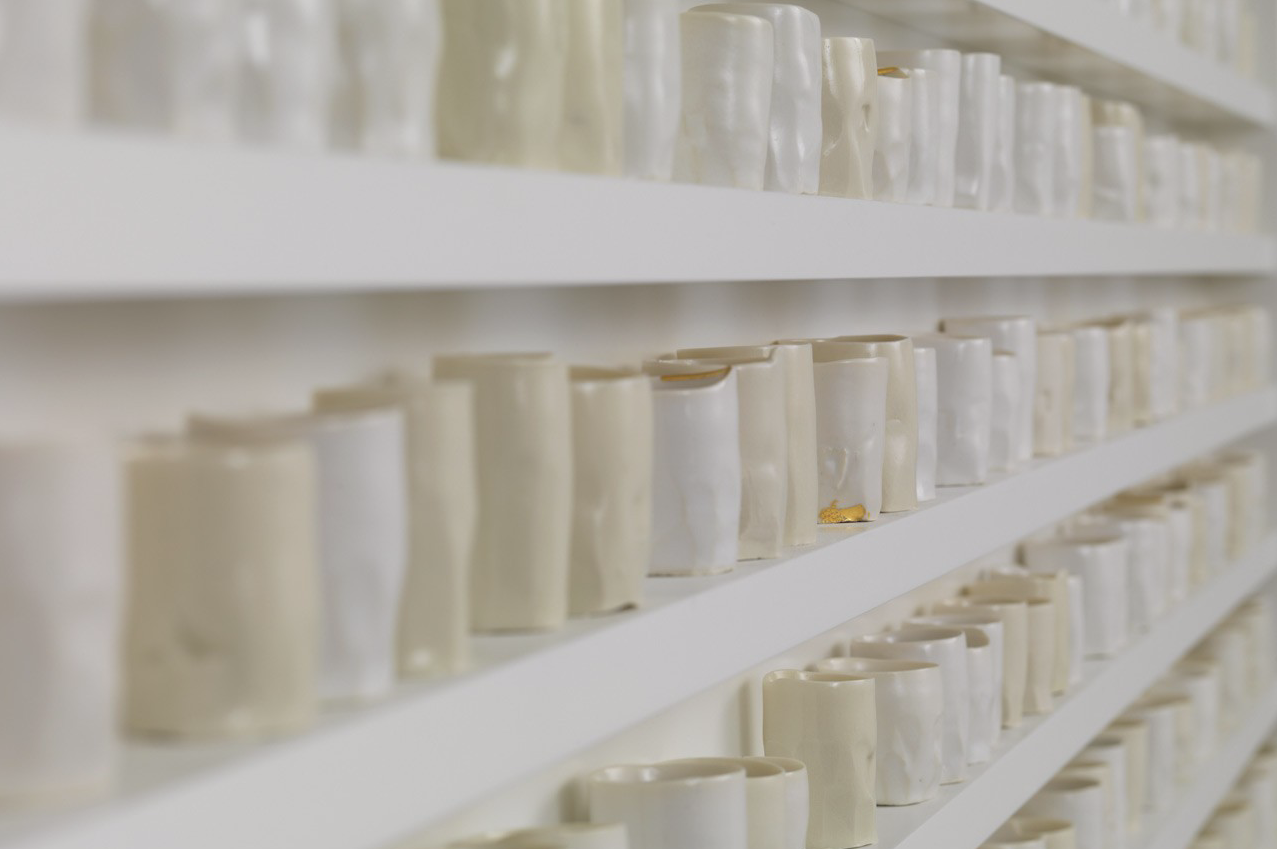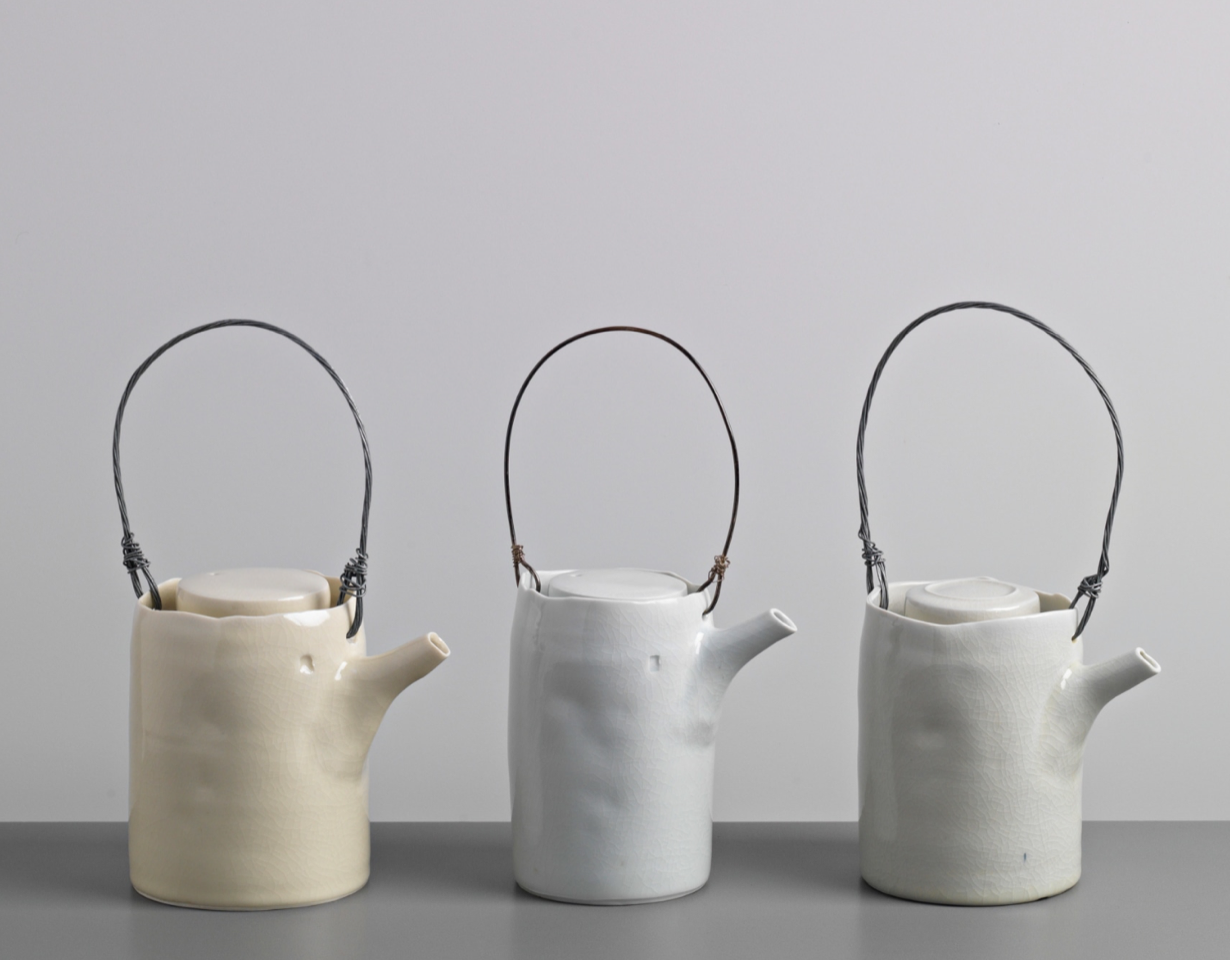
Code in clay
by Victoria Thomas
The ancients called it “white gold”: porcelain.
Its English name is a vulgar reference to the lady-parts of a sow. To be specific, the reference is to the hard, glassy surface of a cowrie shell, which Italian traders named “porcellana”, not for its shiny finish, but for its grooved bottom which alluringly suggests the retreating end of a plump female pig.
But barnyard imagery aside, porcelain is revered as the medium of the masters, a medium of extremes, worked into petal thinness and fired at an infernal 2,462° F, achieving a translucence which defies the its earthly origins.
Edmund de Waal writes of making porcelain, “I am grounded in history, the history and culture of the materials I use, this extraordinary two-thousand year history of porcelain. I don’t use this material lightly. It’s not a light material. It’s got incredible resonance, incredible power.”
De Waal is known not only for his esoteric porcelains, but also for his work as an author. His New York Times bestseller, “The Hare with the Amber Eyes,” chronicles the history of his family’s collection of rare netsuke through la belle époque and the Nazi Holocaust into the present day.
“Clements Shade” photographed by Mark Robson and courtesy of Alice Walton
Alice Walton, a brilliant young British porcelain artist, currently creates her complex layered works as part of a residency with Wedgwood, Britain’s iconic Jasperware house. In email conversations with Soolip, Walton says, “Porcelain is a beautiful, rewarding and satisfying material. It teaches me to think at every stage of making because it is also a very unforgiving material.”
“It warps and moves and shrinks and remembers touches and movements that you have made whilst making. This ‘memory’ or movement that the clay has comes back within the firing, so I have to ensure that each manipulation of the material is thought through. Every mark I make, whether this be a tool mark or a fingerprint, is preserved in the clay’s surface. I choose for its fine, smooth quality to not be covered, coated or inhibited by a glaze. I look back at past work and know exactly how I was feeling and where I was at the time of making.”
The clay remembers, and this persistent sense of recording and summoning past lives permeates the work of Edmund de Waal as well as Walton’s.
Through his writing, de Waal is an archivist of diasporas. His lineage begins in Odessa under the name Ephrussi, where the prominent family first amassed its tremendous wealth in wheat fortunes. Migrating to Vienna and Paris, the family was, in de Waal’s own words, arriviste, ostentatious in their display of wealth through the first decades of the 20th century. Their staggering art collections were plundered during the waves of anti-Semitic persecution that ravaged Europe soon after, the notable survivor being the exquisitely small hare with the amber eyes and its companions.
In his second book, “The White Road”, de Waal chronicles the path of porcelain from China to Europe, taking a bitter turn under the Third Reich when Heinrich Himmler engaged the SS to supervise the production of Nazi Germany’s Allach porcelain using forced labor in Dachau.
Courtesy of the Metropolitan Museum of Art
Some of de Waal’s work may be viewed as a journal or diary. His “Cold Mountain” series was inspired by the poems of Tang Dynasty monk, Hanshan, who wrote his verses on rocks, cave walls and tree-trunks and observed their weathering. In response, de Waal coated wood panels with liquid kaolin, the white clay essential to making porcelain, then floated flecks of gold leaf onto the wet surface as he transcribed lines from Hanshan in graphite, oil stick and charcoal. De Waal then brushed the surfaces with multiple layers of fine slip, suggesting thoughts and memories, imprints and impressions that may be nearly-erased, but remain unforgotten.
In the works of both Walton and de Waal, we are confronted by a strong sense of layering and archiving of thought, experience and emotion. While Walton’s work may suggest organic bio-memory, like accumulating rings in the trunk of ancient trees, De Waal’s art brings to mind the process of human collecting and archiving.
For de Waal, collecting relates to themes of displacement and repression. He recently donated 2,000 books which comprised his “library of exile” to Iraq’s Mosul University Library, which had held more than a million books and rare historical materials, including a Quran from the 9th century CE, before militants of the terrorist Islamic State forces burned the building to the ground in 2014. The 2,000 books comprising de Waal’s donation were all written by exiled authors, from Ovid and Dante to Marina Tsvetaeva and Judith Kerr.
Experts estimate that high-fired white ware pottery originated in the hills of Jingdezhen, China around 500 BCE. Cobalt oxide from Persia was the only pigment that could withstand the temperature of the porcelain kiln, and the Song and Yuan dynasties circa 1330 CE set off a craze for “blue and white” wares. Waves of imitators across Europe attempted to replicate Chinese trade items, and we see the persistent afterglow today in Delftware, Royal Copenhagen, and the much-beloved Blue Willow tableware.
Although in 1704, a German physicist named Ehrenfried Walther von Tschirnhaus successfully broke the code of how Chinese porcelain was made, porcelain was already changing radically. Skilled European copies, like those made in Italy for the Medicis, lacked the gossamer translucence of the originals.
However, in Louis XV’s France. Vincennes or Sevres porcelain emerged in 1750s, with color saturation and lavish gold decoration unmatched by masters in Asia. The production process literally cost lives, with men dying of silicosis and lead poisoning in Louis XV’s porcelain factories.
For both Walton and de Waal, porcelain retains a memory – a scribbled poem, cloaked in clay, a tool-mark, a fingerprint. The medium carries that memory of touch, of skin, like Shadrach, Meshach and Abednego in the Book of Daniel, through the flames of persecution, to endure the test and bear witness to the living. What emerges is the self, one’s very identity, made pure by a passage through fire.
All images, unless otherwise specified, courtesy of Wikimedia Commons.







